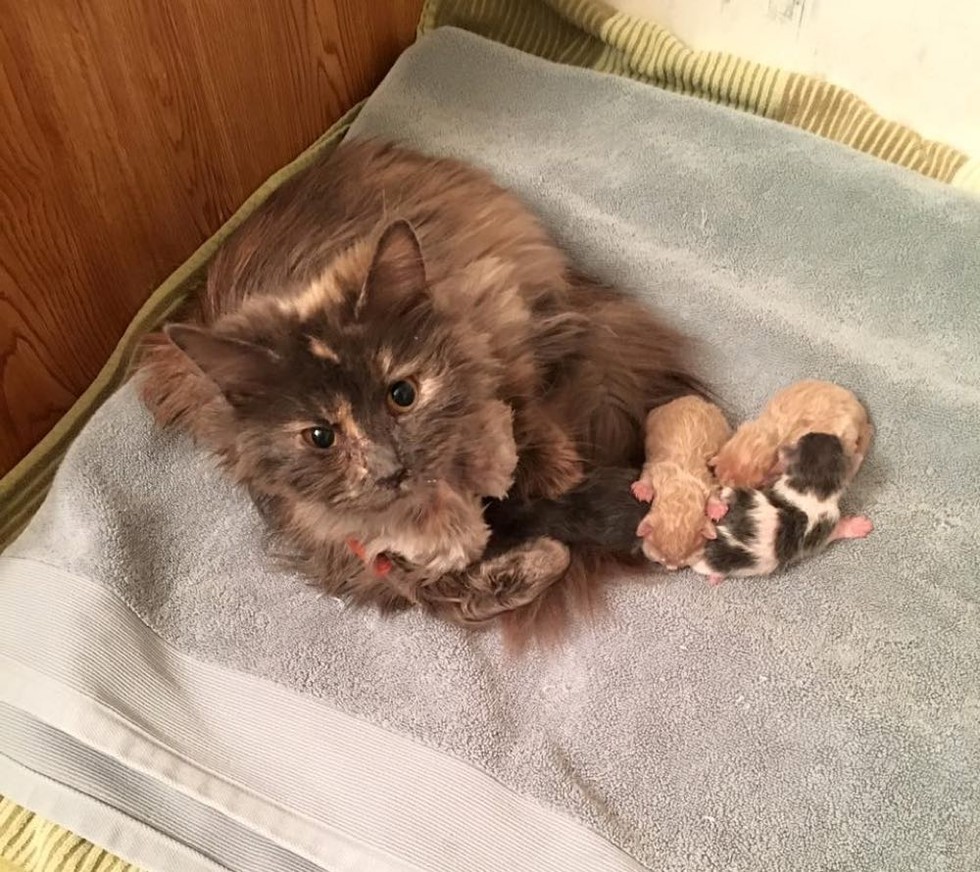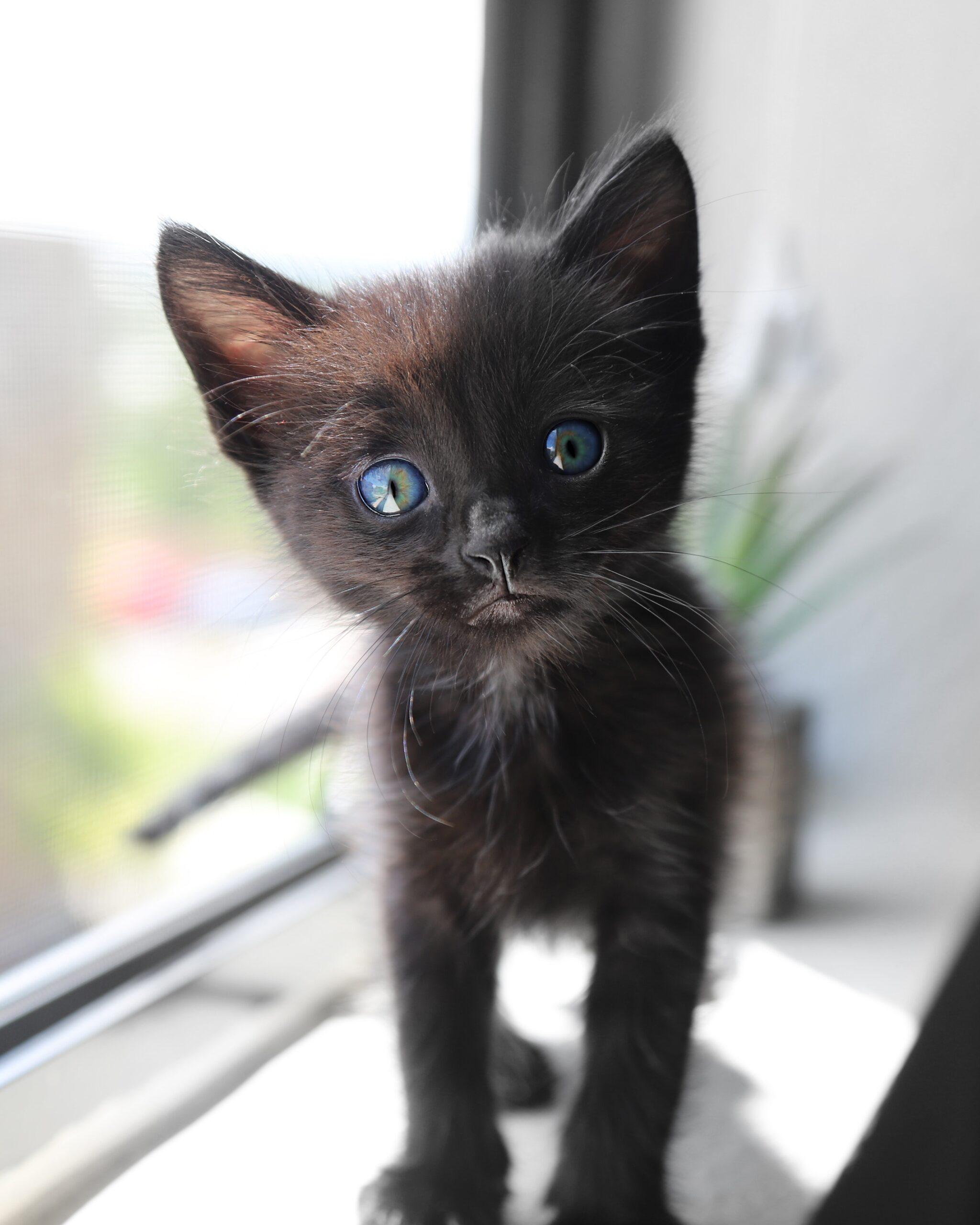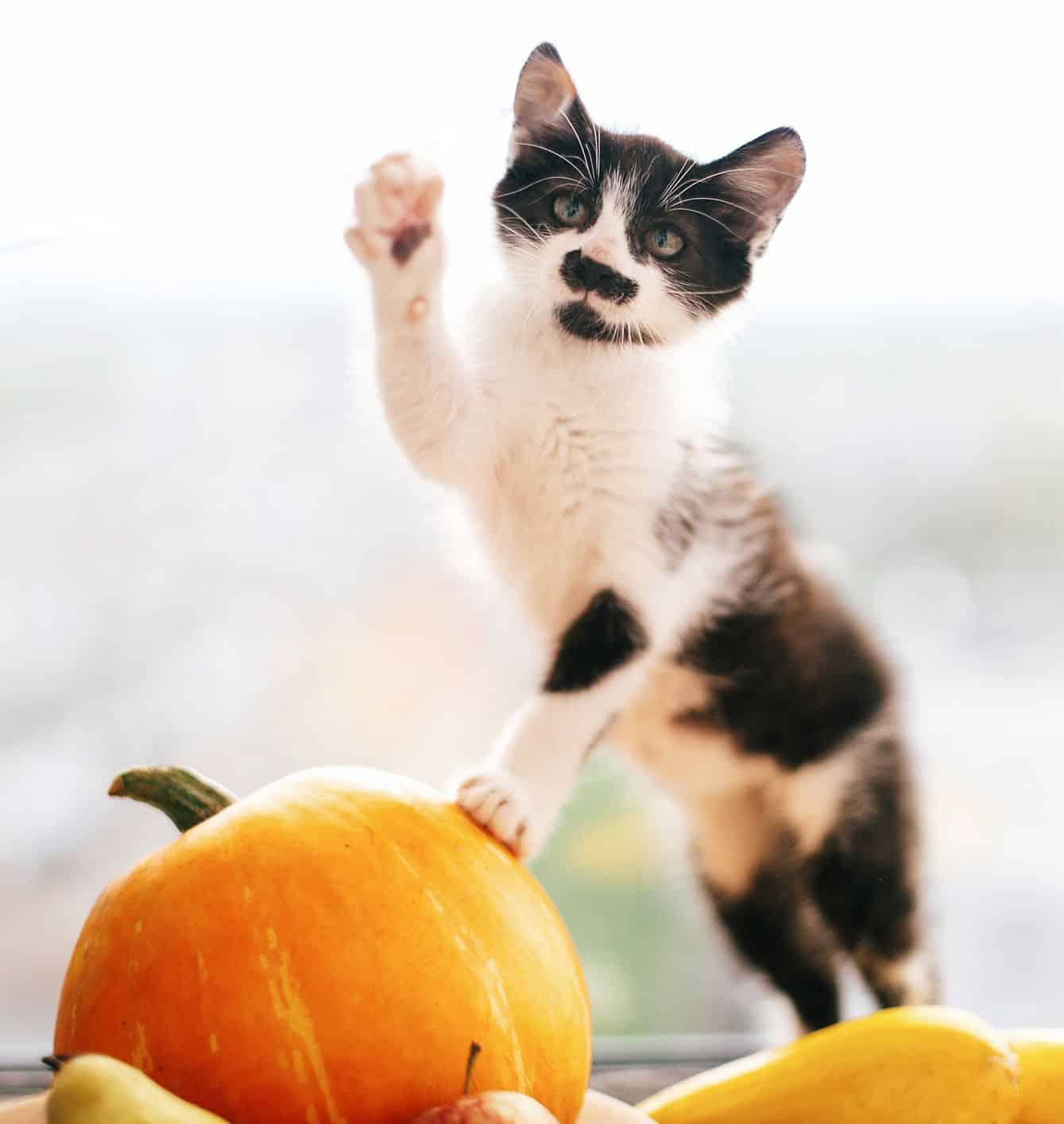How Often To Feed Your Kitten
Wondering how often to feed your kitten? Kittens need to eat little and often, so offer at least 4 small meals a day initially. It is very rare for kittens to over-eat, so they can also be fed ad-lib, as long as you change the food regularly to keep it fresh.
You should monitor your kittens weight daily, to be sure they are getting adequate nutrition. Kittens should gain at least 10grams per day, on average. If your kittens weight gain is less than this or is dropping, contact your vet for advice. Similarly, if their belly looks tucked in, they are crying excessively, or seem cold or weak, you should call your vet straight away.
Recommended Reading: How To Rescue A Stray Cat
How Much Wet Food Or Dry Food To Feed A Kitten
Use your kittens weight to determine approximately how many calories they should be getting each day. Then, look at the label on your kitten food to see how many kcal/kg and kcal/can or kcal/cup it provides. Divide your kittens caloric needs by the foods caloric content to figure out how much of that food to feed your kitten each day. Finally, divide this amount by the number of meals you plan to offer each day to get each meals serving size.
As an example, lets say you have a kitten that is 5 pounds, and you feed them Wellness CORE Natural Grain-Free Turkey & Chicken Liver Pate Canned Kitten Food. According to the chart, you should feed your kitten 327 kcal/day.
Since the calorie content of the wet cat food is 108 kcal/can, you would determine how much wet food to feed your kitten by dividing 327 kcal/day by 108 kcal/can.
327 kcal/day ÷ 108 kcal/can = 3.027 cans of Wellness CORE Naturals Canned Kitten Food per day.
EDITORS TIP:
Introducing Kittens To Solid Food The Right Way
Introducing your kitten to solid food requires patience and time. You will have to make decisions based on your observations, for example, increasing the amount of solid food after a positive reaction from the kitten or switching back to nursing or feeding formulas if your kitten has a hard time weaning.
To introduce your kitten to solid food properly, you should:
- Offer food from your finger first, then switch to a spoon before eventually serving food in a shallow dish
- Try offering your kitten gruel and other mushy food combos before switching to pureed wet and dampened try food
Recommended Reading: How To Get Rid Of Cat Poop Smell Outside
When Is A Kitten Ready To Eat Only Solid Food
Matejka said kittens should not be eating only solid kitten food until they are around eight to 10 weeks old.
Once kittens are eight weeks old, they’re able to digest and absorb the nutrients they need from a kitten diet alone and no longer require their mother’s milk. They should be fed primarily a kitten-specific diet until they’re done growing.
Most cats are fully grown between the age of 10 and 12 months and it’s safe to transition to an adult diet once they are this age, the veterinarian said.
Harrison said: “It is important to keep up the feeding protocol during the first 12 months since kittens continue to develop throughout their first year.”
What Should I Feed Kittens

Harrison said it’s important to feed kittens food that’s formulated specifically for kittens when they’re being weaned.
“These formulas have the higher levels of calories, protein and calcium that growing kittens need,” she said.
Kittens require a precise ratio of nutrients to develop into a healthy adult cat. Matejka said: “Nutritional deficiencies can have lifelong, and sometimes deathly effects.”
Below are the three key nutrients a kitten needs for growth, as outlined at the website of VCA, one of North America’s largest animal hospital chains that operates over 1,000 animal hospitals across the U.S. and Canada.
- Protein: The recommended protein range for healthy kitten growth is 35 to 50 percent on a dry matter basis, with at least nine percent of the dry matter being from an animal source. The amount of protein required for kittens is high during the weaning stage, but steadily decreases afterwards.
- Fat: The fat content range for kittens should be from 18 to 35 percent on a dry matter basis.
- Calcium: A kitten’s diet should contain 0.8 to 1.6 percent of calcium on a dry matter basis.
The VCA website says: “You should also avoid foods that produce a urinary pH of less than 6.2.” Your veterinarian can help determine the pH levels of foods you’re looking to feed your kitten.
“Cats are also particular about food texture. It is recommended that kittens be provided with various food textures early in life to not become opposed to certain types of food later,” she said.
Read Also: My Cat Ate Plastic Bag
Adolescence Stage: 6 To 12 Months
As kittens approach adult size, their nutritional requirements begin to change again. Their rate of growth begins to slow, activity levels may decline and they can start eating fewer, larger meals each day. During this stage, kittens begin to look like adults, but they are still growing and need the special nutrition found in kitten food. Continue feeding your adolescent kitten a high-quality kitten food, such as Opens a new windowIAMS ProActive Health Healthy Kitten with Chicken. During the adolescent growth stage, many cat owners are tempted to change a kittens food for variety. But cats do not get bored with a consistent diet of high-quality dry food, and giving a kitten human food and table scraps can lead to undesirable behaviors, such as begging or stealing food.
Additionally, feeding homemade diets, food formulated for adult cats or supplementing an already complete and balanced diet with vitamins could cause nutritional disorders. You can, however, supplement your kittens dry food with a nutrient-dense Opens a new windowwet kitten or all-life-stages food for a nutritious and tasty
Recommended Reading: Blue Buffalo Weight Management Cat Food
When Can Kittens Start Eating Solid Food
If there is one thing that we can all agree on, it is that kittens are insanely cute. Those of us lucky enough to have their homes overrun by the little critters will be very aware of the responsibility to ensure that they get the best care. A crucial part of this is successfully weaning them from milk onto solid food. The Cats Protection League survey in 2020 found that 16% of all neutered female cats have one litter before they are spayed. Given there are 5.3 million owned female cats in the UK, that equates to a lot of kittens that need to be weaned onto solids. So, whether breeding was intended, or the kittens were an accident, knowing when to start weaning them onto solid food is essential for giving a kitten the best start in life.
Recommended Reading: How To Check Your Cat For Fleas
When To Start Weaning Kittens And What To Feed Them
All kittens will reach a point when they’re ready to graduate from consuming their mother’s milk and move onto solid kitten food. But it’s important to carefully wean them off the milk before this diet change.
Dr. Carling Matejka, a veterinarian who is a spokesperson for pet food company Solid Gold, told Newsweek: “For the first few weeks of a kitten’s life, they need to rely on their mother’s milk to provide all the nutrients they need.”
Transitioning a kitten onto solid food is a slow, gradual process that usually takes between four to six weeks to complete, she said.
Here, cat experts explain when and how to wean kittens.
Why Its Important To Switch To Adult Cat Food
Kittens experience rapid growth and development, plus, theyre playful and have a lot of energy. Kitten food has higher calories and more protein and fat to support energetic, growing kittens.
Its also formulated with DHA to help support brain and vision development, plus vitamins and minerals needed for their developing immune systems.
Once they reach maturity, cats dont need the same amounts of those nutrients. Plus, theyre often less energetic, so eating a high-calorie kitten food could result in weight gain.
You May Like: Antioch Dog And Cat Hospital
When Do Kittens Start Eating Food And Drinking Water
The weaning process involves going from the mothers milk to kibble and water, which is what a kitten will eat and drink in some form for the rest of their lives. If the mother cat is around, shell know when the time is right to start weaning, and its best not to interfere.
Generally, kittens will start to be ready to take small tastes of solid foods and water at around three to four weeks of age. The food and water are complimentary at this young age, so dont worry too much if they play with it more than they eat it. Theyre still getting most of their nutrition from Mom or a formula in a bottle.
Weeks Seven And Eight Feeding Schedules
Limited nursing sessions should still be allowed until the kittens are two months old, assuming they are all eating the kitten food that is offered to them three times a day. The mother cat may need to be separated from kittens that are relentlessly trying to nurse more than they should, but by the end of week eight, a kitten should weigh about two pounds from the combination of limited nursing and eating regular kitten food.
The Spruce / Emilie Dunphy
Also Check: Where Can I Take Stray Kittens
How Much Wet Food Will Feed A Kitten
As kittens grow, their food requirements will increase too. Follow the guidance on the kitten food packaging for the amount to feed depending on age and weight. Younger kittens will be fed several smaller meals a day, decreasing in frequency and increasing in portion size as they get older. If you are concerned that your kitten is not gaining weight as they should be, seek veterinary advice.
Dont Miss: What Is A Savannah Cat Mixed With
Reinforce Good Litter Box Habits

When your kitten uses the litter box appropriately, reward them with their favorite treat to create a positive association with the activity.
For this to work, the treat must be given immediately after they have left the box so they associate the activity with the reward.
If your kitten makes a mistake, do NOT punish them or yell at them. Calmly clean up the mess with an enzymatic cleaner and do not react in any other way.
Recommended Reading: What Happens If A Kitten Eats Cat Food
When & How To Switch From Kitten Food To Adult Cat Food
Around your kittens first birthday , its time to switch to an adult cat food.
We recommend transitioning to adult food over a 7- to 10-day period to help avoid any digestive upset. Heres how:
- Days 1-2: Serve 3/4 of the normal amount of kitten food and add 1/4 of the new adult cat food.
- Days 3-4: Serve half kitten food and half adult cat food.
- Days 5-7: Serve 1/4 kitten food and 3/4 adult cat food.
- Days 8-10: Serve only the new adult cat food.
If your cat resists eating the new food, slow the transition and give her more time before you increase the amount of adult food. Consult with your veterinarian for additional tips on making the switch from kitten food to adult cat food.
For more tips and information on kitten nutrition from our experts, see our Pet Expertise page.
What Do Weaning Kittens Eat
Weaning kittens should start on a mixture of wet food with formula mixed in, and then you can move forward with wet food alone. When your kitten eats wet food with no problem, you can transition them to kitten kibble softened with water. You should only use wet and dry foods made explicitly for kittens since these are higher in calories and have a nutritional profile developed specifically for growing cats.
Don’t Miss: Kittens For Sale In Baltimore
Slowly Increase The Amount Of Food
As the kittens get older, you should slowly increase the amount of food that they get. Until the kittens are weaned, you dont have to worry about them overeating. If they eat more solid food, it will likely cause them to drink less milk, not necessarily eat large amounts of both.
The last thing that you want is for little kittens to go long without a meal, so continue to offer meals multiple times a day. By the time that the kittens are 8 weeks old, you can lower the number of feedings to four or three times a day. It mainly depends on the size of the kittens.
Small breeds need more frequent meals than large breeds.
Give Your Kittens The Best Head Start With Untamed
Many cats have already joined the Untamed packtheir parents happily report that their kitties:
- Make less mess in the litter boxUntamed meals are easy to digest and go easy even on the most sensitive of tummies
- Have more energy throughout the dayYou can expect playtime to get a whole new meaning. Even if your kitty isnt a hunter, they will enjoy all benefits of a natural diet
- Are showing their true coloursProtein-rich meals make your cats coat shiny and silky-soft
Our pack is ever-growing, and wed like to welcome you, too!
Don’t Miss: How Do You Treat A Cat Urinary Tract Infection
When To Stop Feeding Your Cat Kitten Food
When your cat is about 12 months old, its time to switch to a maintenance formula adult cat food, such as Opens a new windowIAMS ProActive Health Adult Original with Chicken. At this age, cats no longer need the extra calories and nutrients found in kitten food. As with any change in a cats diet, remember to gradually transition from kitten food to adult food over a period of several days.
Recommended Reading: Are Schefflera Plants Toxic To Cats
What Makes A Food Suitable For Kittens
Kittens are constantly growing and require a diet that is formulated to meet their nutritional needs and supports proper growth and development. This includes appropriate amounts of vitamins and minerals, amino acids, protein, fat, and more. Other nutritional elements significant to a kittens diet include antioxidants to support a strong immune system, higher protein and calorie content for energy, and DHA, an omega fatty acid, for healthy vision and brain development.
When choosing a food for your kitten, look for the following on the label:
- Complete and balanced
- All Life Stages
These statements indicate that the diet is suitable for kittens according to AAFCO Cat Food Nutrient Profiles.
When feeding your kitten, be sure to check feeding guidelines on the bag and consult with your veterinarian to make sure your kitten is getting enough food. Kittens can benefit from eating 3-4 smaller meals per day.
Recommended Reading: How Long Can Cat Food Be Refrigerated
You May Like: Neutered Cat Spraying In House
What Foods Can Harm Cats
Believe it or not, cats can become poisoned by many of the same foods that dogs can. So if you ever hear of a flavor of these foods, or think you may want to give them things as a supplement please avoid it. They can literally kill your kitten and cat. Some of these are:
- Grapes extremely toxic for cats.
- Raisins Theyre still grapes.
- Onions and Garlic You want to avoid letting your cat have this at all. Some dogs may benefit from small amounts of garlic for control of pests but it is deadly to cats.
- Chocolate Just like a dog, chocolate is a potentially fatal toxin that can harm your cat too.
Wondering What You Should Be Feeding Your Kitten

Newborn kittens get all the nutrition they need in the first few weeks from their mothers milk. The weaning process generally starts between the first and second month.
After weaning, kittens should have a wet or dry complete food to ensure they have all the daily nutrition they require.
As they grow, they need to be eating high-quality food made with real animal protein. They require a much higher level of protein than adult cats in order to support healthy growth, and increased energy levels.
The right amount of vitamins and minerals is also vital for rapidly developing digestive and immune systems.
Food should be easy to digest and delicious.
Dry food is an excellent protein-packed choice, especially when its grain-free.
You May Like: How Many Calories Should A Cat Eat Each Day
Keep Your Options Openfinicky Kittens Can Cause You Trouble
Kittens like to exploreeverything is new to them, including food, so theyre more willing to try different foods than adult cats. When shopping for food, get several options so you can observe the kitten’s reactions to them. As the weaning period comes to an end, you will discover that your kitten has particular preferences and eating habits you need to tend to. Untamed helps you do so because our food assortment caters to all picky eaters.
Options, options Where do I start?
Image Untamed
Introducing Adult Cat Food
Kittens grow and develop every day. They require a food that meets the high-energy demands of their bodies. As your kitten becomes an adult cat, you may need to adjust her diet.
How do you know when to switch to adult cat food? Sometimes its hard to know when to stop feeding kitten food, but generally, you should begin slowly transitioning your kitten to adult food when she is one year old, or when your veterinarian recommends doing so. Spread out the transition process over a 7 to 10-day period, gradually increasing the amount of her new food each day.
This blog article was originally posted by Purina.
Also Check: High Fiber Senior Cat Food